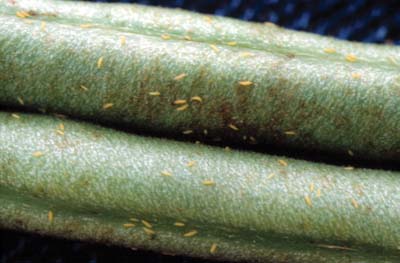To save the Web-optimized images shown below to your hard drive:
|
Click to access Display and Print quality images. |
|
Click to access Display and Print quality images. |
Copyright © 2005 University of Florida
Melon thrips are major pests of the plant families Cucurbitaceae and Solanaceae. Vegetable plants that are injured are bean, cabbage, cantaloupe, cowpea, cucumber, eggplant, lettuce, melon, okra, onion, pea, pepper, potato, pumpkin, squash, and watermelon. Plant leaves that are infested become white or yellowish-brown and then crinkle and die. Heavily infested fields may have a heavy bronze color. Insecticides may be used to suppress thrips populations but may be detrimental to biological control agents that are present in the field. Insecticides are only effective on larvae and adults.
Images
To save the Web-optimized images shown below to your hard drive:

Injury to snap beans caused by melon thrips, Thrips palmi.
(Photographer: J. Capinera, University of Florida)
Click to access Display and Print quality images.

Melon thrips, Thrips palmi, on bean pods.
(Photographer: J. Capinera, University of Florida)
Click to access Display and Print quality images.
Copyright © 2005 University of Florida